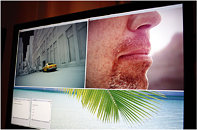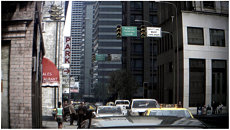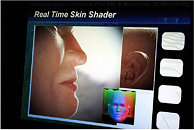Friday, June 27th 2008

Radeon HD4800 Series Supports a 100% Ray-Traced Pipeline
During AMD's recent Cinema 2.0 event, TG Daily caught up with representatives of JulesWorld. They are associated with the video production process of an unnamed movie studio and adopted components that are standard in the FX industry (AMD Opteron + Nvidia Quadro). Ray-tracing was an early focus of the company and they were told that JulesWorld started experimenting with a 100% ray-traced pipeline on a GPU with the arrival of ATI's R600 (2900XT) chip. And the results were impressive.
JulesWorld will be releasing OTOY and LightScape, two distinctive technologies that could shape the future of movie and games production. The company developed a ray-tracer that uses elements of the DirectX 9 API as well as its own high-level code that uses Tessellation and anti-aliasing algorithms.
Urbach further added that ray-tracing in real time became a reality with the Radeon 2900XT - which was used for a series of trailers for last summer's hit-move Transformers. All those Transformers teaser trailers were rendered on a GPU and - more importantly - directed in real-time. The producer of these trailers had complete freedom to play around with a "virtual lens" and direct the trailer in his own way.
In terms of performance, the Radeon 2900XT 1GB rendered Transformers scenes in 20-30 frames per second, in 720p resolution and no Anti-Aliasing. With the Radeon 3870, the test scene jumped to 60 fps, with a drop to 20 fps when the proprietary Anti-Aliasing algorithm was applied. Urbach mentioned that the Radeon 4870 hits the same 60 fps - and stays at that level with Anti-Aliasing (a ray-tracer is not expecting more than 60 fps.) JulesWorld's technology also works on Nvidia GeForce 8800 cards and above, but the lack of a tessellation unit causes a bit more work on the ray-tracer side.
A ray-tracer is limited by the amount of local memory on your video card, so if you are able to get a Radeon 4850 or 4870 with 1 GB or even more of on-board memory, you have very capable hardware. JulesWorld's LightStage technology can take wireframes consisting of an insane 32 million vectors to enable real world characters and their expressions. That means: Extra memory on your graphics card doesn't hurt.
Source:
TG Daily
JulesWorld will be releasing OTOY and LightScape, two distinctive technologies that could shape the future of movie and games production. The company developed a ray-tracer that uses elements of the DirectX 9 API as well as its own high-level code that uses Tessellation and anti-aliasing algorithms.
Urbach further added that ray-tracing in real time became a reality with the Radeon 2900XT - which was used for a series of trailers for last summer's hit-move Transformers. All those Transformers teaser trailers were rendered on a GPU and - more importantly - directed in real-time. The producer of these trailers had complete freedom to play around with a "virtual lens" and direct the trailer in his own way.
In terms of performance, the Radeon 2900XT 1GB rendered Transformers scenes in 20-30 frames per second, in 720p resolution and no Anti-Aliasing. With the Radeon 3870, the test scene jumped to 60 fps, with a drop to 20 fps when the proprietary Anti-Aliasing algorithm was applied. Urbach mentioned that the Radeon 4870 hits the same 60 fps - and stays at that level with Anti-Aliasing (a ray-tracer is not expecting more than 60 fps.) JulesWorld's technology also works on Nvidia GeForce 8800 cards and above, but the lack of a tessellation unit causes a bit more work on the ray-tracer side.
A ray-tracer is limited by the amount of local memory on your video card, so if you are able to get a Radeon 4850 or 4870 with 1 GB or even more of on-board memory, you have very capable hardware. JulesWorld's LightStage technology can take wireframes consisting of an insane 32 million vectors to enable real world characters and their expressions. That means: Extra memory on your graphics card doesn't hurt.



37 Comments on Radeon HD4800 Series Supports a 100% Ray-Traced Pipeline
Let the era of the playable movie begin!
- Depth buffer readback, even though this feature seems to be less precise than the common Z depth tests. You want ray-tracers as precise as you can but...
- PCIe 2.0: A ray-tracer will surely benefit from the increased bandwidth, just as it benefits from the increased frame buffer, but as to make such a difference?
Those two are the only ones that I could think of now. I just woke up so if I think of another one I will post it later. :o
Jurassic Park was a mixture a both Animatronics and CGI...
EDIT: www.lost-world.com/Lost_World02/Jurassic_Park.Site/Jurassic_Park.html
Apparently 3000 lb's of clay lol
Anyway there were some powerful computers back then. They didn't exactly make films on PCs you know ;), they don't make them on PCs today neither. Maybe they start doing it in the future with 4 x HD4870 or 3x GTX280 though... :rolleyes:
Graphics cards can be used totally outside DirectX you know, they can be programed to do whatever you want if you know how to do it. You don't need CUDA or CTM either.
"The company developed a ray-tracer that uses elements of the DirectX 9 API as well as its own high-level code that uses Tessellation and anti-aliasing algorithms."
Anyway the tesselator is a very valuable feature, not only for ray-tracing, so taking out of RV770 wuldn't be a good choice.
On a side note, after a second thought, I don't know why they are using DX9 and not DX10. In reality none of the two are really usable for ray-tracing, as they are focused on rasterization, so maybe the part they are using is almost the same in DX9 and 10 and in 9 they have less overhead or something.
But what really interests me in all this, is that it could give us a hint about why Nvidia didn't bothered to support DX10.1, even though they pretty much support all the features except a few ones. If they knew that ray-tracing on GPUs is possible and that it was not too far away from being feasible to implement it on games, don't you think it makes sense to forget about spending the money on DirectX and use the money in a "better" way like say... buying a ray-tracing company like RayScale? Just a thought.
So my guess is one or more of the following:
1./ Proprietary tessellation routines couldnt access the R600 tessellator for acceleration, due to hardware tessellator not being exposed under DX9 API/compiler
2./ Under DX10.1 the hardware tessellator is exposured, resulting in double performance
3./ There may have been other changes to the proprietary algorithms they coded for AA and didnt notice they were testing different code on the different hardware.
Dark... could you give us a 3 sentence summary of how the tesselator works.
But what about the GTX 280? Surely it can do this Ray-tracing bullshit better. It's more than twice as powerful.
As for this news, I'm impressed. Even if this isnt real time, 1 GPU doing a raytraced scene as complex as their trailers is definately going to be faster than a dual core or quad core CPU of today.